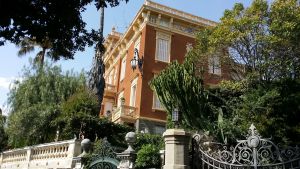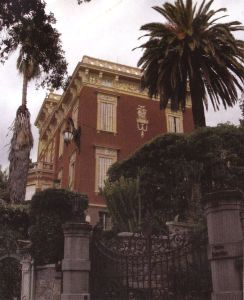The second villa of Baron Thiem
The building development in the west of the town, until then concentrated on the hill overlooking the Corso Imperatrice and around the M. Vittoria public gardens (Casino) suffered towards the end of the 19th century, a considerable increase in the highest part of Corso Inglesi where other new villas were built in the following years. Among them the Villa Virginia.
Situated in Corso Inglesi in a position dominating the hill below, the villa was built between 1883 and 1885 by the German Baron Adolf Thiem on a project by Pio Soli.
 The idea to build the villa came from Thiem, who had already been living in Villa Noseda since the 1870s, in order to house his large collection of works of art in a more spacious and capacious location than the villa located in front of the Maria Vittoria public gardens.
The idea to build the villa came from Thiem, who had already been living in Villa Noseda since the 1870s, in order to house his large collection of works of art in a more spacious and capacious location than the villa located in front of the Maria Vittoria public gardens.
Pio Soli was commissioned to build a large villa whose central nucleus would be an enormous hall, in which the Germanic nobleman would then display his paintings of Venetian and Flemish art, including some masterpieces by Rembrandt and Van Dick, and various statues, illuminated by natural light from the ceiling.
The architectural structure of the building closely resembles that of the almost contemporary Marsaglia Castle with the development of the building in two bodies, one horizontal and the other vertical, soaring into a square tower with a perforated balcony arranged along the profile of the terraces and protruding forepart.  The villa stands out for the particular decorative richness, perhaps inspired by Baron Thiem himself, of the multicoloured decorations that characterise the whole façade and that herald the Liberty style, like the pictorial frieze located under the cimasa characterised by typical phytomorphic motifs.
The villa stands out for the particular decorative richness, perhaps inspired by Baron Thiem himself, of the multicoloured decorations that characterise the whole façade and that herald the Liberty style, like the pictorial frieze located under the cimasa characterised by typical phytomorphic motifs.
After the outbreak of the First World War the Baron decided to leave Sanremo, while his art treasure was largely taken over by the Friedrich Museum in Berlin.
 After the First World War the villa was bought by the engineer Pippo Pedriali, whose wife was called Virginia.
After the First World War the villa was bought by the engineer Pippo Pedriali, whose wife was called Virginia.
Perfectly preserved also in the interiors, the villa still stands out for the presence of valuable period stained glass windows, except for the ceiling of the salon, and the monumental staircase with classical forms.
(sources: text Andrea Gandolfo; images from private archive)




